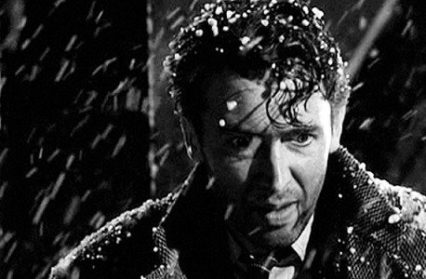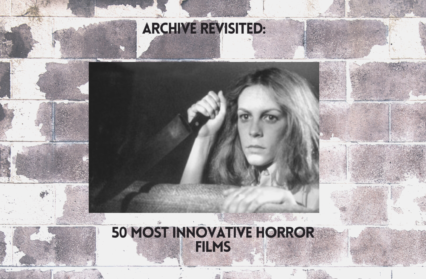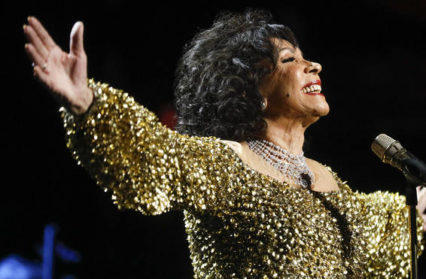Not a year goes by without a nationwide re-release of Frank Capra’s festive classic It’s A Wonderful Life (1946). Over recent years, the film has regularly been screened by mainstream cinema chains in Wales as well as independent venues like Chapter and Tramshed in the capital. This year’s most imaginative showing will take place at the National Waterfront Museum in Swansea. With a musical adaptation by Paul McCartney and Lee Hall (Billy Elliott & Rocketman) seemingly set to bring this magical tale to a whole new generation of fans, Kevin McGrath takes a look at the unique story of how a movie that flopped at the Oscars and which barely made a dent at the box office somehow became an enduring part of Christmas for so many.
Frank Capra’s post-war masterpiece It’s A Wonderful Life has rightly gone down in film history as one of the greatest feel-good movies of all time. From its humble beginnings as The Greatest Gift, an unpublished short story that author Philip Van Doren Stern turned into a 24-page pamphlet-come-Christmas card, it has become the most cherished of all movies, regularly figuring in best picture polls either side of the Atlantic. For many in America, Christmas simply isn’t Christmas without the family gathering around the TV to watch this incredibly affecting festive tale. And it was TV, of course, that had rescued the film from relative obscurity when its copyright was allowed to lapse in 1974. By 1984, The Wall Street Journal discovered, 152 public stations and 175 commercial stations had taken up the rights to broadcast the movie).
The reason that It’s A Wonderful Life continues to stand the test of time today must surely be attributed to the flawless filmmaking of its visionary director Frank Capra. Prior to the outbreak of the Second World War (during which he made the exemplary documentary series, Why We Fight), Capra had established himself as one of Hollywood’s premiere directors, with a string of box office smashes to his name. The most notable of which, 1934’s romantic comedy It Happened One Night, became the first film to win all five major Academy Awards picking up Oscars for Best Picture, Best Actor, Best Actress, Best Screenplay and, of course, Best Director. Capra had become a master craftsman and a master storyteller, specialising in crowd-pleasing ‘moral fables’ about the honest Joe, the American everyman, who stands up for ‘liberal’ ideals and values against corrupt businessmen and politicians.
Screen giants like James Stewart and Gary Cooper had turned in widely acclaimed performances in Capra’s Mr. Smith Goes To Washington and Meet John Doe respectively, and it was to Stewart, his most trusted actor, that Capra turned when casting the part of quintessential nice-guy George Bailey. Stewart, one of the few major stars to enlist in the war against fascism, had been away from Hollywood for the best part of five years, and was in anguish about resuming his acting career when Capra called to offer him the role, that ultimately, film critics would regard as the finest of his distinguished career. Luckily, the director was able to talk Stewart around, and the rest, as they say, is history!
 Stewart’s nuanced portrayal of the decent, unselfish, yet ultimately tormented Bailey, offers us a masterclass in screen acting. It’s as if Stewart had never been away as he plays through a succession of comic, romantic and dramatic scenes with absolute confidence. Stewart is able to convince us of George’s good heart and of his deeply felt moral opposition to scurrilous Banker Henry Potter, whilst also capturing the frustration eating away at his character’s soul as he sees life passing him by and his friends making their own mark on the world. George Bailey is a man desperately divided against himself, as Stewart’s reflective performance gradually makes clear.
Stewart’s nuanced portrayal of the decent, unselfish, yet ultimately tormented Bailey, offers us a masterclass in screen acting. It’s as if Stewart had never been away as he plays through a succession of comic, romantic and dramatic scenes with absolute confidence. Stewart is able to convince us of George’s good heart and of his deeply felt moral opposition to scurrilous Banker Henry Potter, whilst also capturing the frustration eating away at his character’s soul as he sees life passing him by and his friends making their own mark on the world. George Bailey is a man desperately divided against himself, as Stewart’s reflective performance gradually makes clear.
Thankfully, his fellow actors are equally as good, with Lionel Barrymore proving to be an inspired piece of casting in the role of Potter, the Dickensian villain who tries to drive the Bailey family business into ruin in his quest to monopolise the wealth of Bedford Falls. (Capra had surely noted Barrymore’s legendary portrayal of Scrooge for the Campbell Playhouse dramatisation of A Christmas Carol, broadcast each Christmas Eve since 1934). And, as the years have gone by, it’s become impossible to imagine anyone other than the whimsical Henry Travers as the very special emissary Clarence Oddbody, whose celestial mission it is to save George Bailey from the tragic fate that awaits him on Christmas Eve.
The movie begins with George’s family and friends frantically seeking divine intervention to help him through a spiritual crisis at Christmas and uses the device of extended flashbacks to tell the tale of a young boy/college student determined to travel the world, all the while threatening to “shake the dust of this crummy little town off my feet”. He subscribes to National Geographic magazine and spends his days dreaming of “going out exploring someday’. A family tragedy and financial difficulties combine, though, to ensure George’s ambitions are thwarted at every turn, as he finds himself trapped into running the family Building and Loan Company, the only institution in town not owned by slum landlord Potter. George is loved by the whole of Bedford Falls for standing alone against Potter time and again, and, in a crucial scene which illustrates Capra’s humanitarian message, Bailey challenges Potter over his scandalous business practices –
‘Do you know how long it takes a working man to save five thousand dollars? Just remember this, Mr. Potter, this rabble you keep talking about…they do most of the working and paying and living and dying in this community. Well, is it too much to have them work and pay and live and die in a couple of decent rooms and a bath? Anyway, my father didn’t think so. People were human beings to him’.
Stewart is acting out of his straight-laced skin here, violently trembling with anger. For me, it’s one of the most genuinely moving scenes in film history.
Though George has quietly transformed the lives of all those who reside in Bailey Park, he is unable to find consolation in his own achievements. He simply cannot free himself from the resentment he feels, as first his younger brother Harry takes up his place at College, and then as his old friend Sam Wainwright cuts a dash through the business world. Drunk and despairing on Christmas Eve, he wishes he’d never been born.
Throughout the film, Capra remains in complete control of the story. Each scene plays perfectly, the transition between episodes is seamless and the script cohesive from start to finish. This is all the more remarkable given the number of writers involved in developing a screenplay that proved almost impossible to knock into shape. Whilst the final screen credit went to husband and wife screenwriting team Albert Hackett and Frances Goodrich, as well as Capra himself, there were already three fully developed scripts in existence when Capra bought the property from RKO in 1945.
Three of the biggest names in the business had failed spectacularly in adapting Van Doren Stern’s quirky fantasy. Neither Marc Connelly, the Pulitzer winning playwright and fully paid-up member of the Alongquin roundtable, Dalton Trumbo (an Oscar winner for The Brave One) or Clifford Odets, the left-wing firebrand whose work with the Group Theatre had revolutionised Broadway in the thirties, found a way to incorporate the various fantasy/reality elements of the plot into a coherent whole.
While Connolly and Trumbo’s contributions were dismissed out of hand by Capra, some key scenes from the Odets script were retained. According to Jeanine Basinger, curator of the Capra archives, his scripts “bring into focus the elements found in the final movie: the accident on the ice in which Harry nearly drowns; the Gower drug store sequence and George’s marriage to Mary.” It’s worth noting that at this stage the Potter character simply did not exist. The dramatic conflict in each of these scripts was between a good George and an evil George.
None of this turmoil is reflected in the finished movie itself. Capra was able to unfold his story with clarity, balancing the requirements of the plot with his need to convey an uncompromising message to the audience. In the same way that Dickens, who was on a lifelong crusade to improve the conditions of the poor, wrote A Christmas Carol to try and progress social change in Victorian England, so Capra, who was just back from the Second World War, his film cans stuffed with footage of the horrors of the concentration camps, passionately wanted to tell a story that would make a serious statement about the times in which he lived.
Dickens’ plea to his readers was for them to follow the example of a reformed Scrooge when, at the novella’s end, he pledges to “honour Christmas in my heart, and try to keep it all year round”. Capra’s motivation was equally straightforward. He had in mind a reaffirmation of John Donne’s view of the human condition
“No man is an island entire of itself; every man is a piece of the continent, a part of the main”
Still haunted by a war, in which Historians currently estimate, up to 70 million people died, Capra was at pains to point out how one man’s life touches another. His Christmas message was for us all to extend a helping hand to the next fellow.
When I went to see It’s A Wonderful Life at my local cinema, last Christmas, the usherette, on taking my ticket said: “I hope you’ve brought a supply of hankies”. Indeed, I had. I can never get past that early scene in Gower’s drugstore, where the distraught and drunk chemist brutally slaps a young George Bailey around, without breaking down. And, of course, the famous finale with George, having escaped from his nightmare existence in Pottersville, charging joyously through the snowy streets of Bedford Falls on Christmas Eve, wishing everyone and everything a Merry Christmas, has me in floods of tears every time I have the privilege of viewing it.
Watching It’s a Wonderful Life every Christmas, making it a part of the ritual and tradition of the festive period means it can be hard to be wholly objective about the film as a work of art. For good or bad the film comes imbued, perhaps even burdened, with our own memories and associations. In the darkness, as the credits begin to roll, we suddenly sense The Ghost of Christmas past sitting next to us in the cheap seats.
For others, Capra is too sentimental and the derogatory term “Capra-corn” applied by some cynics to his films has stuck over the years. Look beyond the joyous, feel-good message at the centre of It’s A Wonderful Life though, and there is a real darkness rooted within the heart of small-town America. Capra, having witnessed at first hand the atrocities of a World War, knew all about the evil ordinary people were capable of but remained an optimist and a believer in the brotherhood of man, nonetheless.












